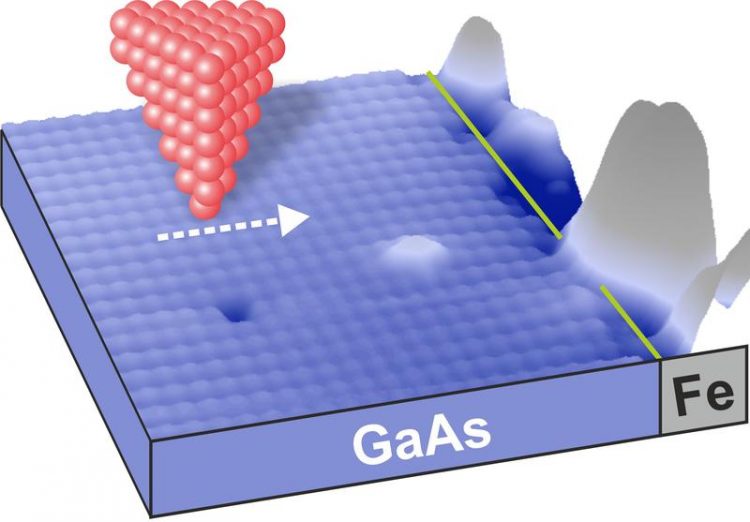Electronic charge distribution on the atomic scale

Novel experiment on metal-semiconductor interfaces: A very sharp metal tip (red) is scanned across the iron/gallium arsenide interface Universität Göttingen
Scientists from the University of Göttingen and the Jülich Research Centre have made an important step towards a deeper understanding of metal-semiconductor interfaces. By means of a novel experimental approach the researchers investigated the distribution of the electronic charge at these interfaces on the atomic scale. Their results were published in the journal Physical Review Letters and highlighted as “Editors’ suggestion”.
In every electronic semiconductor device the interfaces between two different materials play a crucial role. In this context, the atomic and electronic structure of metal-semiconductor interfaces is of fundamental im-portance.
For the development and the design of novel nanometer-sized devices, a basic understanding of these interfaces is of central interest. However, up until now, no commonly accepted model that describes metal-semiconductor interfaces in their entirety existed. This is also due to the fact that scientists did not have an adequate experimental approach to investigate the atomic structure of these interfaces.
Now scientists in Göttingen and Jülich investigated the technologically interesting iron/gallium arsenide inter-face using a scanning tunneling microscope developed in Göttingen. “By scanning a very sharp metal tip across the interface we were able to simultaneously map its structure and its electronic properties on the atomic scale,” explains doctoral candidate Tim Iffländer from Göttingen University’s IV. Physical Institute.
“In combination with theoretical calculations from the colleagues in Jülich we found out that the electronic barrier between metal and semiconductor, on the one hand, is dominated by charges from the metal tailing into the semiconductor and, on the other hand, essentially depends on the chemical bonds between metal and semiconductor as well.”
“The high level of agreement between measured and calculated charge distribution at the interface demon-strates that our experimental approach is particularly well-suited to study the electronic properties of metal-semiconductor interfaces on the atomic scale,” adds Dr. Martin Wenderoth, head of the research group. “This allows us to check the relevance of several theoretical models.
Moreover, our experiment serves as starting point for further studies addressing the influence of defects and the detailed atomic structure at the interface on the electronic properties of metal-semiconductor contacts.”
Original publication: T. Iffländer et al. Local Density of States at Metal-Semiconductor Interfaces: An Atomic Scale Study. Phys. Rev. Lett. 114, 146804 (2015). Doi: 10.1103/PhysRevLett.114.146804 .
Contact:
Dr. Martin Wenderoth
University of Göttingen
Faculty of Physics – IV. Physical Institute
Friedrich-Hund-Platz 1, 37077 Göttingen
Phone +49 551 39-9367 or -4536
Email: wenderoth@ph4.physik.uni-goettingen.de
Web: www.uni-goettingen.de/en/500611.html
Media Contact
All latest news from the category: Physics and Astronomy
This area deals with the fundamental laws and building blocks of nature and how they interact, the properties and the behavior of matter, and research into space and time and their structures.
innovations-report provides in-depth reports and articles on subjects such as astrophysics, laser technologies, nuclear, quantum, particle and solid-state physics, nanotechnologies, planetary research and findings (Mars, Venus) and developments related to the Hubble Telescope.
Newest articles

Webb captures top of iconic horsehead nebula in unprecedented detail
NASA’s James Webb Space Telescope has captured the sharpest infrared images to date of a zoomed-in portion of one of the most distinctive objects in our skies, the Horsehead Nebula….

Cost-effective, high-capacity, and cyclable lithium-ion battery cathodes
Charge-recharge cycling of lithium-superrich iron oxide, a cost-effective and high-capacity cathode for new-generation lithium-ion batteries, can be greatly improved by doping with readily available mineral elements. The energy capacity and…

Novel genetic plant regeneration approach
…without the application of phytohormones. Researchers develop a novel plant regeneration approach by modulating the expression of genes that control plant cell differentiation. For ages now, plants have been the…





















